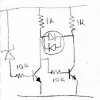Hi there, I am building a portable boombox that runs off of a 22.2v li-ion pack I built.
I would like to be able to know if the batteries are dying/dead in a way other than just hearing my audio suddenly start failing.
I looked up battery level indicator circuits and I've gotten a few mixed messages.
Some such as this suggest using two chips.
I've also learned that Zener Diodes are important and this little kit doesn't suggest using chips at all.
I guess it would be cool if it was a 2 color light and green was good, orange=ok, red=bad, but I would also settle for a light just coming on suggesting "low power"
Also none of the kits I've seen mention working with voltages as high as mine. I figure I could do some shoddy math to adjust it to work for me..
But what would be most awesome is if someone here had a straight answer or suggestion for my case.
Thanks a ton!
I would like to be able to know if the batteries are dying/dead in a way other than just hearing my audio suddenly start failing.
I looked up battery level indicator circuits and I've gotten a few mixed messages.
Some such as this suggest using two chips.
I've also learned that Zener Diodes are important and this little kit doesn't suggest using chips at all.
I guess it would be cool if it was a 2 color light and green was good, orange=ok, red=bad, but I would also settle for a light just coming on suggesting "low power"
Also none of the kits I've seen mention working with voltages as high as mine. I figure I could do some shoddy math to adjust it to work for me..
But what would be most awesome is if someone here had a straight answer or suggestion for my case.
Thanks a ton!

